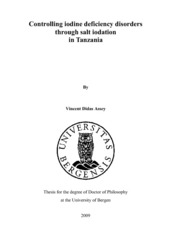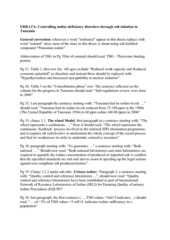| dc.contributor.author | Assey, Vincent Didas | en_US |
| dc.date.accessioned | 2010-01-06T13:23:40Z | |
| dc.date.available | 2010-01-06T13:23:40Z | |
| dc.date.issued | 2009-12-11 | eng |
| dc.identifier.isbn | 978-82-308-0912-9 (print version) | en_US |
| dc.identifier.uri | https://hdl.handle.net/1956/3718 | |
| dc.description.abstract | Background: Iodine deficiency disorders (IDD) is a major public health problem worldwide, in which more than two billion people have insufficient iodine intake, including 285 million school-age children. In Tanzania, 41% of the population is at risk of IDD and 30% of perinatal mortality is estimated to be attributable to iodine deficiency. Iodine deficiency is the number one cause of preventable brain damage in children and an important cause of infant deaths. The most cost-effective health intervention to correct IDD is universal salt iodation (USI). Tanzania has adopted USI since the early 1990s, but not much is known about its impact on the population and the challenges that were met in implementing this programme in the developing world. Objective: The iodine status of the population following iodine supplementation and salt fortification interventions, and performance of salt iodation technologies used to optimise intervention strategies for sustainable elimination of IDD in Tanzania, have been investigated. Methods: Three cross-sectional surveys were carried out in: a) the most iodine deficient areas in 1999; b) low priority intervening areas of Zanzibar islands in 2001; c) a national survey in mainland Tanzania in 2004. These involved testing of salt consumed in the households, analysis of urinary iodine, and goitre assessment in >160 000 school-age children, and d) another survey in mainland Tanzania, which investigated the status of the salt iodation machines and the quality of the product at salt factories. An experimental study was also carried out to improve the local technologies for salt iodation. Results: In the most IDD affected areas in Tanzania, total goitre prevalence (TGP) dropped from 65% in 1980s to 24% in 1999, with 83% of households consuming iodated salt. In Zanzibar islands where there was no intervention, TGP was 25.6%. Pemba Island had a higher TGP of 32% with almost no iodated salt consumed in the households. In mainland Tanzania, a marked improvement was observed in the national survey with a drop of 25% in TGP in school-age children in 1980s to 6.9% in 2004, and currently 94.5% of school children aged 6-12 years have no goitre countrywide. However, excessive iodine intake (>300 μg/l) was found in 35% of the urine samples, raising concern as to the effectiveness of quality control at the salt production factories. Interviews with salt workers indicated that the standard iodation machines previously serving 140 salt works had been abandoned due to high running costs. Instead, simple iodation techniques using sprayers and sprinklers had been adapted to iodinate the salt. However, 24% and 69% of the salt samples analysed from these local technologies were over-iodinated or under-iodinated. The local technologies needed to be evaluated if they were to sustain USI. Improved local iodation methods and procedures, achieved homogenous iodine concentrations with 96% of the salt samples falling within the recommended iodine level of 40-80 ppm. Discussion: It has been demonstrated that a huge improvement in iodine status of large Tanzanian population has resulted from the USI. This might have prevented thousands of child deaths in the country and spared millions of school children from substandard IQ levels, which were both the correct policies. USI has to be extended to cover the Islands of Zanzibar. Locally adopted salt iodation methods with low running costs need to be introduced and maintained in for sustainable IDD elimination. Efforts to enforce salt law and monitor the production and sales of iodated salt have to be stepped up throughout the country for each household to benefit from this cost-effective intervention. | en_US |
| dc.language.iso | eng | eng |
| dc.publisher | The University of Bergen | eng |
| dc.relation.haspart | Paper I: Public Health Nutrition 10(10), Assey, V. D.; Mgoba, C.; Mlingi, N.; Sanga, A.; Ndossi, G. D.; Greiner, T.; Peterson, S., Remaining challenges in Tanzania's efforts to eliminate iodine deficiency, pp.1032-1038. Copyright 2007 The Authors. Published by Cambridge University Press. Reproduced with permission. Published version. The published version is also available at: <a href="http://dx.doi.org/10.1017/S1368980007666695" target="_blank"> http://dx.doi.org/10.1017/S1368980007666695</a> | en_US |
| dc.relation.haspart | Paper II: Food and Nutrition Bulletin 27(4), Assey, V. D.; Greiner, T.; Mzee, R. K.; Abuu, H.; Mgoba, C.; Kimboka, S.; Peterson, S., Iodine deficiency persists in the Zanzibar Islands of Tanzania, pp. 292-299. Copyright 2006 The United Nations University. Published by the International Nutrition Foundation. Reprinted with permission from the Food and Nutrition Bulletin. Published version. | en_US |
| dc.relation.haspart | Paper III: BMC Public Health 9(319), Assey, V. D.; Peterson, S.; Kimboka, S.; Ngemera, D.; Mgoba, C.; Ruhiye, D. R.; Greiner, T.; Ndossi, G. D.; Tylleskar, T., Tanzania national survey on iodine deficiency: impact after twelve years of salt iodation. Copyright 2009 Assey et al; licensee BioMed Central Ltd. Reproduced with permission. Published version. The published version is also available at: <a href="http://dx.doi.org/10.1186/1471-2458-9-319" target="_blank">http://dx.doi.org/10.1186/1471-2458-9-319</a> | en_US |
| dc.relation.haspart | Paper IV: European Journal of Clinical Nutrition 62(2), Assey, V. D.; Peterson, S.; Greiner, T., Sustainable universal salt iodization in low-income countries - time to re-think strategies?, pp. 292-294. Copyright 2008 Nature Publishing Group. Full text not available in BORA due to publisher restrictions. The published version is available at: <a href="http://dx.doi.org/10.1038/sj.ejcn.1602737" target="_blank"> http://dx.doi.org/10.1038/sj.ejcn.1602737</a> | en_US |
| dc.relation.haspart | Paper V: BMC Public Health 9(187), Assey, V. D.; Tylleskar, T.; Momburi, P. B:, Maganga, M.; Reilly, M.; Mlingi, N. V.; Greiner, T.; Peterson, S., Improved salt iodation methods for small scale salt producers in low-resource settings in Tanzania. Copyright 2009 Assey et al; licensee BioMed Central Ltd. Reproduced with permission. Published version. The published version is also available at: <a href="http://dx.doi.org/10.1186/1471-2458-9-187" target="_blank"> http://dx.doi.org/10.1186/1471-2458-9-187</a> | en_US |
| dc.subject | Iodine deficiency | eng |
| dc.subject | Iodated salt | eng |
| dc.subject | Tanzania | eng |
| dc.subject | Goitre prevalence | eng |
| dc.subject | Iodation technologies | eng |
| dc.subject | Sustainable IDD elimination | eng |
| dc.title | Controlling iodine deficiency disorders through salt iodation in Tanzania | en_US |
| dc.type | Doctoral thesis | |
| dc.rights.holder | Vincent Didas Assey | |
| dc.subject.nsi | VDP::Medisinske Fag: 700 | nob |






